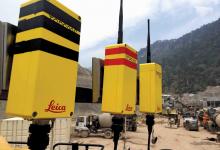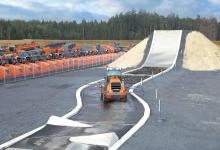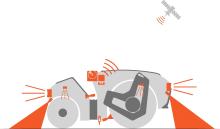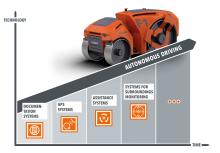As World Highways celebrates its 25-year anniversary this month, we thought that it would be a good moment to take a step back and look at the exciting times we live and work in, and pick out a few of the game-changing new products, technologies and services that have brought about so much innovation in our industry over the past quarter of a century. Where will these new ways of thinking and working take us next?
The global highways market has been transformed in the lifetime of World Highways by high-v
As World Highways celebrates its 25-year anniversary this month, we thought that it would be a good moment to take a step back and look at the exciting times we live and work in, and pick out a few of the game-changing new products, technologies and services that have brought about so much innovation in our industry over the past quarter of a century. Where will these new ways of thinking and working take us next?
The global highways market has been transformed in the lifetime of World Highways by high-value thought leadership and genuine technological revolution. Many economists will tell you that the idea of progress is the theory that “different advances in technology, science, and social organisation can produce an improvement in the human condition. People can become happier in terms of quality of life through economic development and the application of science and technology.” There couldn’t possibly be a more true and accurate description of what our industry does. Roads deliver daily life, and good quality roads transform the societies they serve. Building better roads in a faster time frame at a lower cost remains one of the industry’s most important set of key performance targets. And, as anyone who works in our sector knows, the rhythm of progress seems to have accelerated over the last few decades as new technological breakthroughs and scienti¬ c developments have pushed the highways sector forward.
Many of the innovations that World Highways has covered in the past 25 years did not simply replace other products … they developed new and expanded markets of their own. In the following pages, our writers discuss a wide variety of game-changing ideas such as BIM – building information modelling.
For instance, in partnership with Trimble and the development team behind the Quantm software suite, we take a look at how new ways of working and assessing major projects has moved forward in leaps and bounds. The whole BIM revolution includes design and modelling software as well as things like point clouds. The clever thinking behind it all allows a comprehensive overview of a project through electronic data handling for better design and implementation BIM has also become inextricably linked with modern machine control technologies, including GPS.
The far more ef¬ cient operating standards and improved cost ef¬ ciencies that these ideas have brought allow the huge range of equipment used on site to become signi¬ cantly more ef¬ cient. New machine control systems and remote control centres have slashed project costs for many big contractors and increased the overall quality of delivery. This is especially true for the burgeoning technologies involved in autonomous vehicles. As the R&D experts from Hamm explain in the pages that follow, truly autonomous construction site machines are not quite here yet, but they are coming fast and Hamm has a wide range of rollers on pilot trials.
You only have to take a quick look at the way in which the mining sector has used autonomous machines for more than 20 years to get a avour of how this sort of technology can cut operating costs, boost safety records and improve working ef ciency. Thought leaders and industry experts from Ammann, Shell, Astec, Bentley and Roadtec have also joined forces with us in this special edition to examine the different ways in which their vision has brought about major changes in the way we work. These are exactly the sort of companies that will help the next 25 years be as fast-moving as the quartercentury we have all just experienced.
As Philips Lighting explains, street lighting is rapidly being brought into the “Internet of Things” and new systems promise considerable operational cost savings, often up to 60% because of the LED technologies being used. Out-of-order street lights can be repaired faster than previously – or even replaced before they fail with preventative maintenance. At present, slightly under 12% of the world’s street lights use LEDs and just 2% are connected. However, these gures are anticipated to rise and Philips Lighting is making sure it is well placed to spread the word.
The company now has more than 700 street lighting projects underway in 36 countries around the globe. At Shell, World Highways spoke to Professor John Read and, as he explains, "roads have long been regarded as a barometer of a country or community’s prosperity. The World Bank has said that it is better to invest a dollar in roads than a dollar in irrigation. If you connect two villages, they begin to trade. That creates wealth which is used to purchase goods. Then you create the next village road and trade link. Of course, the same is true in developed markets. Roads create markets and drive – literally – the connectivity between communities; they are the lifeblood of society. Economic and social costs of managing and developing the road network are enormous. Take the European network for instance. It consists of 5.5 million kilometres and it would cost over €8,000 billion (nearly US$9 billion) to reconstruct. As a result, safeguarding and future-proo ng our road networks is an urgent imperative for today and tomorrow.”
This is especially true today in cities and major conurbations where roads have to be safer, more durable and laid out under much more challenging conditions than ever before. That’s due to a variety of factors: increased urbanisation, impact of climate on pavements, greater volume of traf c and heavier vehicular loads. And it will all rest on a surface made from things like game-changing bitumens.
Find out how new thinking at leading players like Shell is changing the visual appearance (the phosphorescence) of road pavement surfaces in order to provide ambient lighting, alert traf c to changes of road driving conditions or even danger. Work is now underway with suppliers of phosphorescent products and universities dedicated to tailoring phosphorescent products in order to investigate the real feasibility of producing phosphorescent asphalt mixes. And then there is the way in which a road surface can take harmful substances like nitrogen dioxide (NO2) or particulate matter out of the air, with the residue washed away with the rain.
The way in which road surfaces have been laid down has changed in the past 25 years too. As Jürgen Seemann, product manager roads for Leica Geosystems, explains: “When Leica Geosystems’ pioneering 3D paving control system was launched a decade ago, it truly revolutionised the way paving was done. Completely removing stringlines, users’ productivity, quality and safety are signi cantly increased. The Leica PaveSmart 3D monitors, with the use of various positioning sensors (total stations or GNSS, depending on required accuracy and setting), the position of the machine versus the 3D project data. In case of a deviation, this data is instantly sent back to the machine control system, which sends a signal to the hydraulics for correction of slope or elevation. In case of a malfunction or too large a deviation from the 3D design project, the Leica PaveSmart 3D system sends a stop signal to the machine to avoid incorrect operation. For slipform operation, PaveSmart 3D controls elevation, slope and steering. For asphalt paving, PaveSmart 3D is able to monitor elevation, slope, working width and steering, but this functionality depends very much on the OEM.”
New low-emission diesel engines, clever new forms of surfacing yet to be invented, hybrid excavators and smart city ITS ideas are all going to go on helping us drive forward a global highway design, construction and maintenance industry that is a clean, clever and efficient way to deliver the modern world. The game, as always, is changing every day.
The global highways market has been transformed in the lifetime of World Highways by high-value thought leadership and genuine technological revolution. Many economists will tell you that the idea of progress is the theory that “different advances in technology, science, and social organisation can produce an improvement in the human condition. People can become happier in terms of quality of life through economic development and the application of science and technology.” There couldn’t possibly be a more true and accurate description of what our industry does. Roads deliver daily life, and good quality roads transform the societies they serve. Building better roads in a faster time frame at a lower cost remains one of the industry’s most important set of key performance targets. And, as anyone who works in our sector knows, the rhythm of progress seems to have accelerated over the last few decades as new technological breakthroughs and scienti¬ c developments have pushed the highways sector forward.
Many of the innovations that World Highways has covered in the past 25 years did not simply replace other products … they developed new and expanded markets of their own. In the following pages, our writers discuss a wide variety of game-changing ideas such as BIM – building information modelling.
For instance, in partnership with Trimble and the development team behind the Quantm software suite, we take a look at how new ways of working and assessing major projects has moved forward in leaps and bounds. The whole BIM revolution includes design and modelling software as well as things like point clouds. The clever thinking behind it all allows a comprehensive overview of a project through electronic data handling for better design and implementation BIM has also become inextricably linked with modern machine control technologies, including GPS.
The far more ef¬ cient operating standards and improved cost ef¬ ciencies that these ideas have brought allow the huge range of equipment used on site to become signi¬ cantly more ef¬ cient. New machine control systems and remote control centres have slashed project costs for many big contractors and increased the overall quality of delivery. This is especially true for the burgeoning technologies involved in autonomous vehicles. As the R&D experts from Hamm explain in the pages that follow, truly autonomous construction site machines are not quite here yet, but they are coming fast and Hamm has a wide range of rollers on pilot trials.
You only have to take a quick look at the way in which the mining sector has used autonomous machines for more than 20 years to get a avour of how this sort of technology can cut operating costs, boost safety records and improve working ef ciency. Thought leaders and industry experts from Ammann, Shell, Astec, Bentley and Roadtec have also joined forces with us in this special edition to examine the different ways in which their vision has brought about major changes in the way we work. These are exactly the sort of companies that will help the next 25 years be as fast-moving as the quartercentury we have all just experienced.
As Philips Lighting explains, street lighting is rapidly being brought into the “Internet of Things” and new systems promise considerable operational cost savings, often up to 60% because of the LED technologies being used. Out-of-order street lights can be repaired faster than previously – or even replaced before they fail with preventative maintenance. At present, slightly under 12% of the world’s street lights use LEDs and just 2% are connected. However, these gures are anticipated to rise and Philips Lighting is making sure it is well placed to spread the word.
The company now has more than 700 street lighting projects underway in 36 countries around the globe. At Shell, World Highways spoke to Professor John Read and, as he explains, "roads have long been regarded as a barometer of a country or community’s prosperity. The World Bank has said that it is better to invest a dollar in roads than a dollar in irrigation. If you connect two villages, they begin to trade. That creates wealth which is used to purchase goods. Then you create the next village road and trade link. Of course, the same is true in developed markets. Roads create markets and drive – literally – the connectivity between communities; they are the lifeblood of society. Economic and social costs of managing and developing the road network are enormous. Take the European network for instance. It consists of 5.5 million kilometres and it would cost over €8,000 billion (nearly US$9 billion) to reconstruct. As a result, safeguarding and future-proo ng our road networks is an urgent imperative for today and tomorrow.”
This is especially true today in cities and major conurbations where roads have to be safer, more durable and laid out under much more challenging conditions than ever before. That’s due to a variety of factors: increased urbanisation, impact of climate on pavements, greater volume of traf c and heavier vehicular loads. And it will all rest on a surface made from things like game-changing bitumens.
Find out how new thinking at leading players like Shell is changing the visual appearance (the phosphorescence) of road pavement surfaces in order to provide ambient lighting, alert traf c to changes of road driving conditions or even danger. Work is now underway with suppliers of phosphorescent products and universities dedicated to tailoring phosphorescent products in order to investigate the real feasibility of producing phosphorescent asphalt mixes. And then there is the way in which a road surface can take harmful substances like nitrogen dioxide (NO2) or particulate matter out of the air, with the residue washed away with the rain.
The way in which road surfaces have been laid down has changed in the past 25 years too. As Jürgen Seemann, product manager roads for Leica Geosystems, explains: “When Leica Geosystems’ pioneering 3D paving control system was launched a decade ago, it truly revolutionised the way paving was done. Completely removing stringlines, users’ productivity, quality and safety are signi cantly increased. The Leica PaveSmart 3D monitors, with the use of various positioning sensors (total stations or GNSS, depending on required accuracy and setting), the position of the machine versus the 3D project data. In case of a deviation, this data is instantly sent back to the machine control system, which sends a signal to the hydraulics for correction of slope or elevation. In case of a malfunction or too large a deviation from the 3D design project, the Leica PaveSmart 3D system sends a stop signal to the machine to avoid incorrect operation. For slipform operation, PaveSmart 3D controls elevation, slope and steering. For asphalt paving, PaveSmart 3D is able to monitor elevation, slope, working width and steering, but this functionality depends very much on the OEM.”
New low-emission diesel engines, clever new forms of surfacing yet to be invented, hybrid excavators and smart city ITS ideas are all going to go on helping us drive forward a global highway design, construction and maintenance industry that is a clean, clever and efficient way to deliver the modern world. The game, as always, is changing every day.














